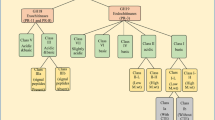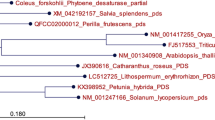Abstract
The tobacco cutworm (Spodoptera litura) is a polyphagous foliage insect and a major pest on peanut (Arachis hypogaea L.). S. litura is susceptible to the chimeric δ-endotoxin Cry1EC reported earlier. De-embryonated cotyledon explants of peanut were transformed using Agrobacterium tumefaciens strain EHA101 harboring a synthetic cry1EC gene driven by the CaMV 35S promoter. Transgenic plants of peanut with a single copy insertion of cry1EC were selected in the T0 generation by Southern blot hybridization. Real-time PCR, Western blot and ELISA analysis indicated that expression of the cry1EC gene was higher in single copy T1 plants. Immunoassay showed expression of Cry1EC up to 0.13% of total soluble protein in T1 plants. Leaf feeding bioassay on highly expressing transgenic lines showed 100% killing of larvae at the 2nd instar stage of S. litura. This is the first report of transgenic peanut plants with resistance to S. litura.






Similar content being viewed by others
Abbreviations
- BAP:
-
6-Benzylaminopurine
- hptII :
-
Hygromycin phosphotransferase
- SIM:
-
Shoot induction medium
References
Cheng M, Jarret RL, Li Z, Xing A, Demski JW (1996) Production of fertile transgenic peanut (Arachis hypogaea L.) plants using Agrobacterium tumefaciens. Plant Cell Rep 15:653–657
Day CD, Lee E, Kobayashi J, Holappa LD, Albert H, Ow DW (2000) Transgene integration into the same chromosome location can produce alleles that express at a predictable level, or alleles that are differentially silenced. Genes Dev 14:2869–2880
De Buck S, Van Montagu M, Depicker A (2001) Transgene silencing of invertedly repeated transgenes is released upon deletion of one of the transgenes involved. Plant Mol Biol 46:433–445
Dufourmantel N, Tissot G, Goutorbe F, Garcon F, Muhr C, Jansens S, Pelissier B, Peltier G, Dubald M (2005) Generation and analysis of soybean plastid transformants expressing Bacillus thuringiensis Cry1Ab protoxin. Plant Mol Biol 58:659–668
Gamborg OL, Miller RA, Ojima K (1968) Nutrient requirements of suspension cultures of soybean root cells. Exp Cell Res 50:151–158
Ghewande MP, Desai S, Basu MS (2002a) Diagnosis and management of major diseases of groundnut. Bulletin, National Research Centre for Groundnut, Junagadh, India
Ghewande MP, Nandagopal V, Desai S, Basu MS (2002b) Integrated pest management in groundnut. Bulletin, National Research Centre for Groundnut, Junagadh, India
Harlow Ed, Lane D (1999) Using antibodies: a laboratory manual. Cold Spring Harbor Laboratory, New York
Hobbs SLA, Kpodar P, Delong CMO (1990) The effect of T-DNA copy number, position and methylation on reporter gene expression in tobacco transformants. Plant Mol Biol 15:851–864
Hood EE, Helmer GL, Fraley RT, Chilton MD (1986) The hypervirulence of Agrobacterium tumefaciens A281 is encoded in a region of pTiBo542 outside of T-DNA. J Bacteriol 168:1291–1301
Kay R, Chan A, Daly M, McPherson J (1987) Duplication of CaMV 35S promoter sequences creates a strong enhancer for plant genes. Science 236:1299–1302
Laemmli UK (1970) Cleavage of structural proteins during the assembly of the head of bacteriophage T4. Nature 227:680–685
Li Z, Jarret RL, Demski JW (1997) Engineered resistance to tomato spotted wilt virus in transgenic peanut expressing the viral nucleocapsid gene. Transgenic Res 6:297–305
Livak KJ, Schmittgen TD (2001) Analysis of relative gene expression data using real-time quantitative PCR & the 2−ΔΔC T method. Methods 25:402–408
Matzke AJ, Matzke MA (1998) Position effects and epigenetic silencing of plant transgenes. Curr Opin Plant Biol 1:142–148
McKently AH, Moore GA, Doostdar H, Niedz RP (1995) Agrobacterium-mediated transformation of peanut (Arachis hypogaea L.) embryo axes and the development of transgenic plants. Plant Cell Rep 14:699–703
Murashige T, Skoog F (1962) A revised medium for rapid growth and bioassays with tobacco tissue cultures. Physiol Plant 15:473–497
Naimov S, Dukiandjiev S, Maagd RA (2003) A hybrid Bacillus thuringiensis delta-endotoxin gives resistance against a coleopteran and a lepidopteran pest in transgenic potato. Plant Biotech J 1:51–57
Olhoft PM, Flagel LE, Donovan CM, Somers DA (2003) Efficient soybean transformation using hygromycin B selection in the cotyledon-node method. Planta 216:723–735
Prasad MNR, Gowda MVC (2006) Mechanisms of resistance to tobacco cutworm (Spodoptera litura F.) and their implications to screening for resistance in groundnut. Euphytica 149:387–399
Sanyal I, Singh AK, Kaushik M, Amla DV (2005) Agrobacterium-mediated transformation of chickpea (Cicer arietinum L.) with Bacillus thuringiensis cry1Ac gene for resistance against pod borer insect Helicoverpa armigera. Plant Sci 168:1135–1146
Sharma KK, Anjaiah V (2000) An efficient method for the production of transgenic plants of peanut (Arachis hypogaea L.) through Agrobacterium tumefaciens-mediated genetic transformation. Plant Sci 159:7–19
Shelton AM, Zhao JZ, Roush RT (2002) Economic, ecological, food safety, and social consequences of the deployment of Bt transgenic plants. Ann Rev Entomol 47:845–881
Singh K, Raizada J, Bhardwaj P, Ghawana S, Rani A, Singh H, Kumar S (2004a) 26S rRNA-based internal control gene primer pair for reverse transcription-polymerase chain reaction-based quantitative expression studies in diverse plant species. Anal Biochem 335:330–333
Singh PK, Kumar M, Chaturvedi CP, Yadav D, Tuli R (2004b) Development of a hybrid δ-endotoxin and its expression in tobacco and cotton for control of a polyphagous pest Spodoptera litura. Transgenic Res 13:397–410
Singsit C, Adang MJ, Lynch RE, Anderson WF, Wang A, Cardineau G, Ozias-Akins P (1997) Expression of a Bacillus thuringiensis cry1A(c) gene in transgenic peanut plants and its efficacy against lesser cornstalk borer. Transgenic Res 6:169–176
Srinivasa Reddy MS, Dinkins RD, Glenn B, Collins GB (2003) Gene silencing in transgenic soybean plants transformed via particle bombardment. Plant Cell Rep 21:676–683
Stalker HT, Moss JP (1987) Speciation cytogenetics, and utilization of Arachis species. Adv Agron 41:1–40
Stewart Jr CN, Adang MJ, All JN, Boerma HR, Cardineau G, Tucker D, Parrott WA (1996) Genetic transformation, recovery, and characterization of fertile soybean transgenic for a synthetic Bacillus thuringiensis cryIAc gene. Plant Physiol 112:121–129
Surekha Ch, Beena MR, Arundhati A, Singh PK, Tuli R, Dutta-Gupta A, Kirti PB (2005) Agrobacterium-mediated genetic transformation of pigeon pea (Cajanus cajan (L.) Millsp.) using embryonal segments and development of transgenic plants for resistance against Spodoptera. Plant Sci 169:1074–1080
Tiwari S, Tuli R (2008) Factors promoting efficient in vitro regeneration from de-embryonated cotyledon explants of Arachis hypogaea L. Plant Cell Tissue Organ Cult 92:15–24
Yang H, Singsit C, Wang A, Gonsalves D, Ozias-Akins P (1998) Transgenic peanut plants containing a nucleocapsid protein gene of tomato spotted wilt virus show divergent levels of gene expression. Plant Cell Rep 17:693–699
Acknowledgments
The authors are grateful to Dr. K. Chandrasekhar and S. M. H. Abidi for insect bioassays, Council of Scientific and Industrial Research, Government of India for financial support and fellowship to Siddharth Tiwari, Devesh K. Mishra and Ankit Singh.
Author information
Authors and Affiliations
Corresponding author
Additional information
Communicated by P. Ozias-Akins.
Electronic supplementary material
Below is the link to the electronic supplementary material.
299_2008_525_MOESM3_ESM.doc
Table 1S Quantification of cry1EC transcript by real-time PCR. The amplification plots shown in Fig. 2S were used to calculate 2-DDCT values for the five transgenic lines. The results given in the last column are presented graphically in Fig. 4 in the manuscript (doc 109 kb)
Rights and permissions
About this article
Cite this article
Tiwari, S., Mishra, D.K., Singh, A. et al. Expression of a synthetic cry1EC gene for resistance against Spodoptera litura in transgenic peanut (Arachis hypogaea L.). Plant Cell Rep 27, 1017–1025 (2008). https://doi.org/10.1007/s00299-008-0525-x
Received:
Revised:
Accepted:
Published:
Issue Date:
DOI: https://doi.org/10.1007/s00299-008-0525-x




